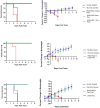An anti-Shiga toxin VHH nanobody multimer protects mice against fatal toxicosis when administered intramuscularly as repRNA
- PMID: 39392311
- PMCID: PMC11556087
- DOI: 10.1128/iai.00239-24
An anti-Shiga toxin VHH nanobody multimer protects mice against fatal toxicosis when administered intramuscularly as repRNA
Abstract
Hemolytic uremic syndrome (HUS) is a systemic sequelae from gastrointestinal infection with Shiga toxin (Stx) producing Escherichia coli (STEC) that can result in acute kidney injury, lasting renal disease, and death. Despite a window for intervention between hemorrhagic diarrhea and onset of HUS, no specific therapies exist to prevent or treat HUS following STEC infection. Furthermore, there is no way to predict which patients with STEC will develop HUS or any rapid way to determine which Stx variant is present. To address this, we have broadened the therpay to neutralize additional toxin variants. It contains a multimer of nanobodies derived from camelid heavy chain antibody fragments (VHHs). An improved
Keywords: E. coli O157; Shiga toxins; Stx mouse toxicity model; Stx treatment.
Conflict of interest statement
The authors declare no conflict of interest.
Figures






Similar articles
-
A single VHH-based toxin-neutralizing agent and an effector antibody protect mice against challenge with Shiga toxins 1 and 2.Infect Immun. 2013 Dec;81(12):4592-603. doi: 10.1128/IAI.01033-13. Epub 2013 Sep 30. Infect Immun. 2013. PMID: 24082082 Free PMC article.
-
Adenovirus vector expressing Stx1/Stx2-neutralizing agent protects piglets infected with Escherichia coli O157:H7 against fatal systemic intoxication.Infect Immun. 2015 Jan;83(1):286-91. doi: 10.1128/IAI.02360-14. Epub 2014 Nov 3. Infect Immun. 2015. PMID: 25368111 Free PMC article.
-
A Poly-N-acetylglucosamine-Shiga toxin broad-spectrum conjugate vaccine for Shiga toxin-producing Escherichia coli.mBio. 2014 Mar 25;5(2):e00974-14. doi: 10.1128/mBio.00974-14. mBio. 2014. PMID: 24667709 Free PMC article.
-
INM004: Polyclonal Neutralizing Antibodies Against Shiga Toxin as a Treatment for Hemolytic Uremic Syndrome.Toxins (Basel). 2025 Jun 5;17(6):282. doi: 10.3390/toxins17060282. Toxins (Basel). 2025. PMID: 40559860 Free PMC article. Review.
-
Pathogenic role of inflammatory response during Shiga toxin-associated hemolytic uremic syndrome (HUS).Pediatr Nephrol. 2018 Nov;33(11):2057-2071. doi: 10.1007/s00467-017-3876-0. Epub 2018 Jan 25. Pediatr Nephrol. 2018. PMID: 29372302 Review.
Cited by
-
Small but Mighty: Nanobodies in the Fight Against Infectious Diseases.Biomolecules. 2025 Apr 23;15(5):610. doi: 10.3390/biom15050610. Biomolecules. 2025. PMID: 40427503 Free PMC article. Review.
References
-
- Brandal LT, Wester AL, Lange H, Løbersli I, Lindstedt BA, Vold L, Kapperud G. 2015. Shiga toxin-producing Escherichia coli infections in Norway, 1992-2012: characterization of isolates and identification of risk factors for haemolytic uremic syndrome. BMC Infect Dis 15:324. doi:10.1186/s12879-015-1017-6 - DOI - PMC - PubMed
Publication types
MeSH terms
Substances
Grants and funding
LinkOut - more resources
Full Text Sources

